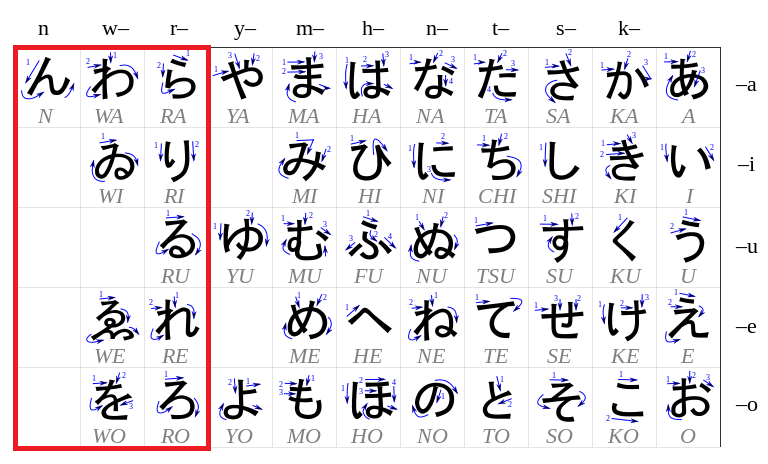Overview

Hello everyone! Today, we will be going through the final lesson of the Hiragana table. This should be a pretty quick lesson, so hang in there, we’re about to reach the end!
Hiragana – Eighth column
The eighth column is associated with the ‘r’ sound, so the first letter, ら, is read as ‘rah’, and so on. Take note that there should be some tongue-rolling in the pronunciation of the ‘r’ sound in Japanese.





Hiragana – Final Two Columns
The ninth column of the Hiragana table is associated with the ‘w’ sound, so the first letter, わ, is read as ‘wah’. The fifth letter, を, however, is always pronounced as お, and is used as a particle preceding a verb, but more on that in the future.
There is only one letter in the tenth column, ん, and is it just an ‘n’ sound, used at the end of other letters. For instance, てん is read exactly like the number ‘ten’.



What of ゐ (Wi) and ゑ (We) as in the Hiragana table, then? These two letters were used in the past, mainly for diphthongs, but they are considered obsolete today.
Example Words
Below are some words and phrases that can be formed by combining all the letters in the Hiragana table.
- にわ (Niwa) – Garden
- べんきょう (Benkyou) – Study
- わるい (Warui) – Bad
- とり (Tori) – Bird
- やはり (Yahari) – As I expected
- むり (Muri) – Impossible
- わらい (Warai) – Laugh
- りゅう (Ryuu) – Dragon
- いぎあり!(Igiari!) – Objection!
- しんじつ (Shinjitsu) – Truth
- けつろん (Ketsuron) – Conclusion
- いろ (Iro) – Color
- しろい (Shiroi) – White
- くろい (Kuroi) – Black
- れんしゅう (Renshuu) – Practice
Conclusion
Congratulations! You’ve reached the end of the series of lessons for Hiragana~! Here’s a cookie for managing to stick with us thus far. I hope you’ll continue practicing reading and writing the Hiragana characters, and I hope that you’ll move on to the next lesson on Katakana.
Once again, thanks to edowin for doing such a great job on recording pronunciations!
